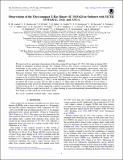Observations of the Ultra-compact X-Ray Binary 4U 1543-624 in Outburst with <i>NICER, INTEGRAL, Swift</i>, and ATCA
Author(s)
Ludlam, R. M.; Shishkovsky, L.; Bult, P. M.; Miller, J. M.; Zoghbi, A.; Strohmayer, T. E.; Reynolds, M.; Natalucci, L.; Miller-Jones, J. C. A.; Jaisawal, G. K.; Guillot, S.; Gendreau, K. C.; García, J. A.; Fiocchi, M.; Fabian, A. C.; Chakrabarty, D.; Cackett, E. M.; Bahramian, A.; Arzoumanian, Z.; Altamirano, D.; ... Show more Show less
DownloadPublished version (1.105Mb)
Publisher Policy
Publisher Policy
Article is made available in accordance with the publisher's policy and may be subject to US copyright law. Please refer to the publisher's site for terms of use.
Terms of use
Metadata
Show full item recordAbstract
© 2019. The American Astronomical Society. All rights reserved.. We report on X-ray and radio observations of the ultra-compact X-ray binary 4U 1543-624 taken in August 2017 during an enhanced accretion episode. We obtained Neutron Star Interior Composition Explorer (NICER) monitoring of the source over a ∼10 day period during which target-of-opportunity observations were also conducted with Swift, INTErnational Gamma-Ray Astrophysics Laboratory (INTEGRAL), and the Australia Telescope Compact Array. Emission lines were measured in the NICER X-ray spectrum at ∼0.64 keV and ∼6.4 keV that correspond to O and Fe, respectively. By modeling these line components, we are able to track changes in the accretion disk throughout this period. The innermost accretion flow appears to move inwards from hundreds of gravitational radii (R g = GM/c 2) at the beginning of the outburst to <8.7 R g at peak intensity. We do not detect the source in radio, but are able to place a 3σ upper limit on the flux density at 27 μJy beam-1. Comparing the radio and X-ray luminosities, we find that the source lies significantly away from the range typical of black holes in the - plane, suggesting a neutron star primary. This adds to the evidence that neutron stars (NSs) do not follow a single track in the - plane, limiting its use in distinguishing between different classes of NSs based on radio and X-ray observations alone.
Date issued
2019-09Department
MIT Kavli Institute for Astrophysics and Space ResearchJournal
Astrophysical Journal
Publisher
American Astronomical Society
ISSN
1538-4357
Keywords
Space and Planetary Science, Astronomy and Astrophysics